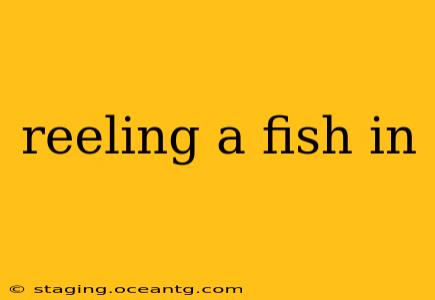Landing a fish after a thrilling fight is the ultimate reward for any angler. But simply reeling in line isn't enough; a successful catch requires technique, patience, and the right equipment. This guide will cover everything you need to know to reel in your fish safely and effectively, from understanding different reeling techniques to handling various fish species.
What's the Best Way to Reel in a Fish?
The "best" way to reel in a fish depends heavily on the species, its size, the type of tackle you're using, and the environment. However, some general principles apply:
- Start Slowly: Avoid jerking or applying excessive pressure initially. This allows the fish to tire itself out and minimizes the risk of breaking your line or pulling the hook. Let the fish run for a bit if it's strong, especially initially.
- Maintain Steady Pressure: Once the initial burst of energy subsides, maintain a steady, consistent pressure on the line. This prevents the fish from gaining slack and keeps it under control. Avoid slack line as much as possible.
- Pump and Wind: This technique involves alternating between reeling in the slack line and letting the fish take line again. This allows you to slowly gain ground without applying too much pressure at any one time. It is effective for larger fish and helps prevent line breakage.
- Use Your Drag: Your fishing reel's drag system is crucial. Properly adjusted drag will prevent line breaks by giving when the fish pulls hard. It's essential to set your drag appropriately for the weight of your line and the size of the fish you expect to catch. Practice setting your drag before heading out on the water.
- Know When to Give Line: Sometimes, giving the fish a little line is the best strategy. This is especially true if it's making powerful runs towards structures like submerged logs or rocks where the line could snag. Allowing the fish to run can also help it tire itself out.
How Do You Reel in a Big Fish?
Reeling in a big fish requires extra patience, stamina, and the right gear. Here are some specific tips:
- Use Heavy-Duty Tackle: Your rod, reel, and line must be strong enough to handle the stress of a large fish. Don't skimp on quality gear; it will pay off in the end.
- Maintain a Good Fighting Position: Keep your rod tip bent and your body in a position that allows you to absorb the fish's powerful runs. Avoid letting the fish get too close to obstacles.
- Take Your Time: Don't rush the process. A big fish can put up a long and exhausting fight. Take breaks when necessary to avoid fatigue and maintain control.
- Netting the Fish: Once the fish is close enough to the boat or shore, use a net to land it safely. A well-placed net will save you the stress of handling a large, potentially aggressive fish.
What Should You Do When a Fish Breaks Your Line?
This can be frustrating, but it's part of fishing. Analyze what happened. Did you use the right tackle for the fish? Was your line damaged or old? Was your drag set correctly? Learning from mistakes will make you a better angler.
How Do You Reel in a Fish Without a Reel?
This is less common in modern fishing, but in some scenarios (e.g., using a handline or a very simple setup), you'll be reeling in with just your hand. This is incredibly demanding, requiring strength and patience. Slowly and steadily bring the line in, managing any sudden runs from the fish as best you can.
How Do You Safely Land a Fish After Reeling It In?
Once you've reeled the fish in close, carefully lift it from the water using a net or by gently grasping it. Consider using appropriate handling techniques to avoid injuring the fish, particularly if you intend to release it. Always prioritize safety for yourself and the fish.
Conclusion
Reeling in a fish is more than just cranking the reel. It's a combination of skill, technique, and understanding of your equipment and the fish you're targeting. By following these tips, you'll increase your chances of landing more fish safely and successfully. Remember to always prioritize responsible fishing practices.
